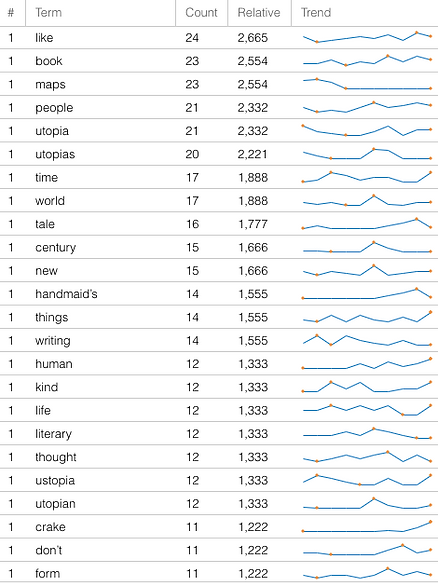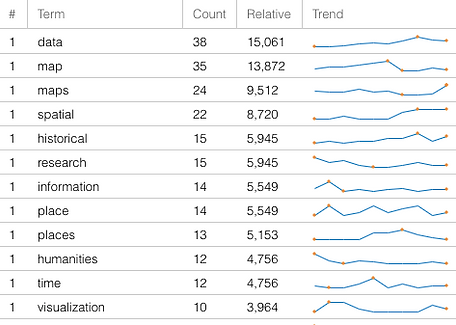Distant reading comparison
Distant Reading Comparison
Comparison Analysis
Words mentioned 10+ times
-
"Maps" is the third most popular word in both"Dire Cartographies" and "Spatial Humanities," with it appearing 23 times in "Dire Cartographies" and 24 times in "Spatial Humanities."
-
"Time" is the seventh most used word in "Dire Cartographies" at 17 mentionings, whereas in "Spatial Humanities," "time" is the eleventh most used word at 12 mentionings.
-
Atwood implements many more words more than 10 times than Wrisley does, which makes sense, considering that her essay is significantly longer.
-
Atwood mentions"place"11 times, whereas Wrisley mentions it 14 times.
-
Wrisley writes the word "historical" 15 times and this word, and despite Atwood using history as a basis upon which to project thoughts about the future, she does not use the word "historical" once in her essay.
Word Trends in the text
-
Atwood uses the word "maps" significantly more frequently in the beginning of her text than she does in the middle of ending of it. Atwood uses maps to introduce the ideas of utopia, dystopia, and ustopia, as well as the rest of her ideas, in this essay, but one would not necessarily know that from this visualization, as one would have to close read the text to make that connection to the visualization. One would just be able to see that "maps" is implemented much more frequently in the beginning than in the middle or end of the essay.
-
These word maps do not include any of the words on literal maps in "Spatial Humanities." Much of Wrisley's essay is commenting on images of maps and data, with several of them including words superimposed on the image itself, making them undetectable by the Voyant Tools software. In this way, distant reading provides an analysis of only part of Wrisley's essay, with the text part being anaylzed and the images being neglected. Only part of the story is able to be told here, which is the same with Atwood's piece, considering that distant reading neglects the value that close reading brings, but this is even moreso considering that the images add to much of Wrisley's piece.
45 Most Used Words
-
Similar to the list of words used 10+ times listed in order of their frequency, the word maps including the 45 most used words in each essay only show their frequency and not their relevance to the ideas expressed within the text. For example, "like" is the most used word in "Dire Cartographies." This says nothing about the piece, as "like" is an article and that perhaps Atwood provides examples in the text or creates similes using "like."
-
However, distant reading the 45 most used words provide data that the human eye would not be able to gather, as it would be impossible to analyze how frequently "maps" is used in each text as quickly as a tool like Voyant Tools can gather this information. In this way, distant reading provides valuable data, like how often "maps" is used in both of these pieces respectively, that enable them to be put in conversation with each other, as well as other pieces that include the word "maps."
Word Links
-
Both "Word Links" visualizations include the word"maps" and words related to "maps" within each text. In "Dire Cartographies," "maps" is related to "early," "edges," "drew," "journeys," "space." In "Spatial Humanities," "maps" is related to "atlases," "cartodb," "time," "make," and "humanities."
-
The "Word Links" do not provide any context as to how these words are related to each other or how they modify each other. in this way, the full story is not being told through this visualization or through the other visualizations. In order for the full story to be told, one would have to juxtapose the findings in distant reading with the findings from the close readings to provide a more comprehensive understanding of both texts individually and in conversation with each other.








